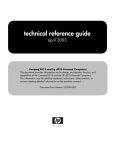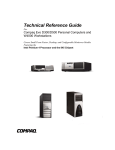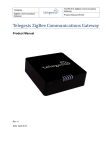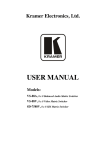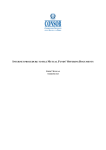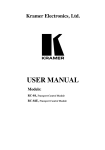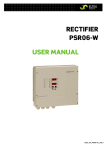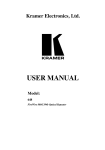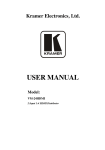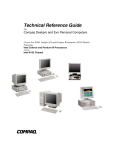Download USER MANUAL - AV-iQ
Transcript
Kramer Electronics, Ltd. USER MANUAL Model: FC-10ETH Ethernet Controller Contents Contents 1 2 3 3.1 3.2 4 5 5.1 Introduction Getting Started Overview Terminology Used in this User Manual Achieving the Best Performance Your FC-10ETH Ethernet Controller Configuring the FC-10ETH Ethernet Controller Connecting the FC-10ETH Ethernet Port 1 1 1 3 3 3 5 5 5.1.1 5.1.2 Connecting Directly to a PC (Crossover Cable) Connecting via a Network Hub or Network Router (Straight-Through Cable) 6 8 5.2 Installing and Configuring the FC-10ETH 8 5.2.1 Understanding the Kramer Configuration Manager Window 5.3 Routing Data in the Passive and Active Routing Modes 11 5.3.1 5.3.2 The Passive Routing Mode The Active Routing Mode 11 11 6 6.1 Controlling Machines via the Ethernet using the FC-10ETH Controlling a Machine via a Computer 12 12 6.1.1 6.1.2 Setting a Virtual Port Setting an Ethernet Connection 13 15 6.2 7 7.1 7.2 7.3 8 Controlling a Kramer Machine via a Controller Flash Memory Upgrade Downloading from the Internet Connecting the PC to the RS-232 Port Upgrading Firmware Technical Specifications 15 18 18 18 18 19 9 i Contents Figures Figure 1: FC-10ETH Ethernet Controller Figure 2: Underside of the FC-10ETH Ethernet Controller Figure 3: RJ-45 PINOUT Figure 4: Local Area Connection Properties Window Figure 5: Internet Protocol (TCP/IP) Properties Window Figure 6: Connecting the FC-10ETH for Configuration Figure 7: FC-10ETH Configuration Manager Window Figure 8: Connecting the FC-10ETH in the Passive Routing Mode Figure 9: The Virtual Serial Port Manager Window Figure 10: The Virtual Serial Port Properties Window Figure 11: The Virtual Serial Port Properties Window (COM 3 and COM 4) Figure 12: The Port Window – Selecting a Virtual Serial Port Figure 13: The Port Window – Selecting a Remote Connection Figure 14: Connecting the FC-10ETH in the Active Routing Mode Figure 15: The KFR-Programmer Window 4 4 6 7 7 9 9 13 13 14 14 14 15 17 19 Tables Table 1: Terminology Used in this User Manual Table 2: FC-10ETH Ethernet Controller Functions Table 3: Crossover Cable RJ-45 PINOUT Table 4: Straight-through Cable RJ-45 PINOUT Table 5: FC-10ETH Configuration Manager Window Functionality Table 6: Technical Specifications of the FC-10ETH Ethernet Controller ii 3 5 6 8 10 19 KRAMER: SIMPLE CREATIVE TECHNOLOGY Introduction 1 Introduction Welcome to Kramer Electronics (since 1981): a world of unique, creative and affordable solutions to the infinite range of problems that confront the video, audio and presentation professional on a daily basis. In recent years, we have redesigned and upgraded most of our line, making the best even better! Our 350-plus different models now appear in 8 Groups1, which are clearly defined by function. Congratulations on purchasing your Kramer TOOLS FC-10ETH Ethernet Controller, which is ideal for use with Ethernet / RS-232 interfaces and/or Ethernet / RS-485 interfaces. The package includes the following items: FC-10ETH Ethernet Controller Power adapter (12V DC Input) Windows®-based Configuration Manager Null-modem adapter This user manual2 2 Getting Started We recommend that you: Unpack the equipment carefully and save the original box and packaging materials for possible future shipment Review the contents of this user manual Use Kramer high performance high resolution cables3 3 Overview The high performance FC-10ETH Ethernet Controller is an easy-to-use, bi-directional hardware and software interface system for controlling Kramer (and also non-Kramer) RS-232 and/or RS-485 controllable machines via Ethernet LAN, as well as via the Internet. 1 GROUP 1: Distribution Amplifiers; GROUP 2: Video and Audio Switchers, Matrix Switchers and Controllers; GROUP 3: Video, Audio, VGA/XGA Processors; GROUP 4: Interfaces and Sync Processors; GROUP 5: Twisted Pair Interfaces; GROUP 6: Accessories and Rack Adapters; GROUP 7: Scan Converters and Scalers; and GROUP 8: Cables and Connectors 2 Download up-to-date Kramer user manuals from our Web site at http://www.kramerelectronics.com 3 The complete list of Kramer cables is on our Web site at http://www.kramerelectronics.com 1 Overview In particular, the FC-10ETH: Offers network connectivity that lets you connect a Kramer (or other) device via its RS-232 or RS-485 port to the Ethernet LAN network1 Lets you control two RS-2322 devices via Ethernet, from a PC (set to the Passive routing mode) or other protocol compatible remote controller3 Lets you control a device from up to five Ethernet points (PCs or remote controllers) Includes Windows®-based Configuration Management software for configuring the FC-10ETH unit (including routing mode settings, network settings, serial settings, and destination device settings) Supports easy dial-up and Internet system remote control (requiring only a dedicated IP address and a modem in the remote location) whether it is a standalone PC or a LAN system Supports using wireless, 802.11b standard based LAN systems Has the capability to facilitate a built-in Web page server4 Has a 128-byte data buffer making it compatible with most non-Kramer protocols The FC-10ETH includes the Virtual Serial Port driver for compatibility with applications based on COM-port communication. The virtual serial port: Makes the FC-10ETH compatible with all Windows®-based applications which work through an actual COM port. This includes all versions of K-Router and other Kramer control applications. It lets you operate all RS-232 and RS-485 controllable devices via Ethernet LAN using their existing PC software Operates like an actual hardware port, that is, a logical COM that behaves like a standard hardware COM but in reality transparently reroutes the data using the TCP/IP network to the FC-10ETH interface via a Virtual Null-modem connection, which you can emulate over the Ethernet or Internet Can be created in any quantity on your PC and does not occupy an actual serial port 1 The FC-10ETH data buffer is limited to 128 bytes 2 Or one RS-232 device and one RS-485 device 3 For example, using the Kramer RC-3000 as illustrated in Figure 14 4 Check our Web site at http://www.kramerelectronics.com for detailed instructions 2 KRAMER: SIMPLE CREATIVE TECHNOLOGY Your FC-10ETH Ethernet Controller 3.1 Terminology Used in this User Manual Table 1 defines some terms that are used in this user manual. Table 1: Terminology Used in this User Manual Term Definition The standard specification for ETHERNET that is maintained by the Institute of Electrical and Electronics Engineers (IEEE). Dynamic Host Allows the network administrator to distribute IP addresses from a central point and Configuration automatically send a new IP address when an Ethernet point is plugged into a different Protocol (DHCP) network location Gateway A network position serving as an entry to another network. On the Internet, a node or stopping point can be either a gateway node or a host (end-point) node. IP Address A 32-binary digit number that identifies each sender or receiver (within a network via a particular server or workstation) of data (HTML pages or e-mails) that is sent in packets across the Internet. Every device connected to an IP network must have a unique IP address. This address is used to reference the specific unit. Local Area Network Computers sharing a common communications line or wireless link, which often share a (LAN) server within a defined geographic area. Media Access A computer's unique hardware number (or address) in a LAN or other network. On an Control (MAC) Ethernet LAN, the (MAC) address is identical to the Ethernet address. Address Transmission The basic communication language or protocol of the Internet that breaks the message Control into appropriately sized packets for the network, and can be used as a communications Protocol/Internet protocol in an intranet or an extranet. Protocol (TCP/IP) 802.3 3.2 Achieving the Best Performance To achieve the best performance: Connect only good quality connection cables, thus avoiding interference, deterioration in signal quality due to poor matching, and elevated noiselevels (often associated with low quality cables) Avoid interference from neighboring electrical appliances and position your Kramer FC-10ETH away from moisture, excessive sunlight and dust 4 Your FC-10ETH Ethernet Controller Figure 1 and Figure 2 illustrate the FC-10ETH Ethernet Controller and Table 2 defines the FC-10ETH Ethernet Controller functions. 3 Your FC-10ETH Ethernet Controller Figure 1: FC-10ETH Ethernet Controller Figure 2: Underside of the FC-10ETH Ethernet Controller 4 KRAMER: SIMPLE CREATIVE TECHNOLOGY Configuring the FC-10ETH Ethernet Controller Table 2: FC-10ETH Ethernet Controller Functions # 1 2 3 4 5 6 7 8 9 10 11 12 13 5 Feature Function 12V DC RS-232 COM 1 port ETHERNET port RS-232 COM 2 port RS-485 Terminal Block Port +12V DC connector for powering the unit Connects to the RS-232 DB-9 port on the Kramer (or other) device 1 or PC Connects to your LAN 1 Connects to the RS-232 DB-9 port on a Kramer (or other) device 2 or PC 1 Connects to the RS-485 port on a Kramer (or other) device PIN A connects to the “A” (+) PIN; PIN B connects to the “B” (–) PIN (and PIN 2 G connects to the “G (Ground)” PIN , if necessary) 3 STATUS COM 1 LEDs Lit when a signal is transmitted or received from port 1 3 STATUS COM 2 LEDs Lit when a signal is transmitted or received from port 2 ON LED Lit when receiving power 4 RESET Button Press to reset the machine RS-485 TERM. Button Press for BUS termination: Set to OFF if the RS-485 terminal block port is not connected Set to ON if the RS-485 terminal block port is connected FACTORY RESET Button Press to reset to factory default definitions5 PROG Switch Switch ON to upgrade firmware CONFIG Switch Not used, set to OFF Configuring the FC-10ETH Ethernet Controller This section describes: How to connect the FC-10ETH for configuration, via its ETHERNET port (see section 5.1) How to install and run the Configuration Manager software (see section 5.2) The Configuration Manager Window features (see section 5.2.1) 5.1 Connecting the FC-10ETH Ethernet Port To configure your FC-10ETH, either connect the Ethernet port6 of the unit: Directly to the PC, using a crossover cable (see section 5.1.1) or Via a network hub or network router, using a straight-through cable (see section 5.1.2) 1 A Kramer device can be connected to either the RS-232 COM 2 port, or to the RS-485 terminal block port (but not to both) 2 The connection to G is usually not necessary for RS-485 3 Mostly used for troubleshooting 4 Turns the machine off and on again while retaining its definitions (identical to disconnecting the power adapter and then connecting it again) 5 First disconnect the power adapter and then connect it again while pressing the FACTORY RESET button. The unit will power up and load its memory with the factory default definitions 6 After connecting the Ethernet port, you have to install and configure your Ethernet Port 5 Configuring the FC-10ETH Ethernet Controller 5.1.1 Connecting Directly to a PC (Crossover Cable) Connect the ETHERNET port of the FC-10ETH to the LAN port on your PC, via a crossover cable with RJ-45 connectors, as Table 3 and Figure 3 define: Table 3: Crossover Cable RJ-45 PINOUT EIA /TIA 568A Side 1 PIN 1 2 3 4 5 6 7 8 Wire Color White-orange Orange White-green Blue White-blue Green White-brown Brown EIA /TIA 568B Side 2 PIN 1 2 3 4 5 6 7 8 Wire Color White-green Green White-orange Blue White-blue Orange White-brown Brown Pair 1 4 and 5 Pair 1 Pair 2 1 and 2 Pair 2 4 and 5 3 and 6 Pair 3 3 and 6 Pair 3 1 and 2 Pair 4 7 and 8 Pair 4 7 and 8 Figure 3: RJ-45 PINOUT This type of connection is recommended for identification of the factory default IP Address of the FC-10ETH during the initial configuration After connecting the Ethernet port, configure your network card as follows: 1. Right-click the My Network Places icon on your desktop. 2. Select Properties and right-click Local Area Connection Properties. 3. Select Properties. The Local Area Connection Properties window appears. 4. Select Internet Protocol (TCP/IP) and click the Properties Button (see Figure 4). 6 KRAMER: SIMPLE CREATIVE TECHNOLOGY Configuring the FC-10ETH Ethernet Controller Figure 4: Local Area Connection Properties Window 5. Select Use the following IP Address1, and fill in the details as shown in Figure 5. Figure 5: Internet Protocol (TCP/IP) Properties Window 6. Click OK. 1 This IP address is compatible with the factory default IP address of the unit 7 Configuring the FC-10ETH Ethernet Controller 5.1.2 Connecting via a Network Hub or Network Router (Straight-Through Cable) To connect the ETHERNET port of the FC-10ETH to the LAN port on a network hub or network router, use a straight-through cable with RJ-45 connectors, as Table 4 defines: Table 4: Straight-through Cable RJ-45 PINOUT Side 1 PIN 1 2 3 4 5 6 7 8 Side 2 Wire Color White-orange Orange White-green Blue White-blue Green White-brown Brown PIN 1 2 3 4 5 6 7 8 Wire Color White-orange Orange White-green Blue White-blue Green White-brown Brown 5.2 Installing and Configuring the FC-10ETH To configure the FC-10ETH via the ETHERNET, do the following: 1. Connect the FC-10ETH as described in section 5.1 (see Figure 6) 2. Insert the CD-ROM in the CD-ROM drive, double click the Setup.exe file and follow the on-screen instructions. 3. Click the appropriate shortcut in the Start menu’s Programs folder. The FC-10ETH Configuration Manager window (see Figure 7) opens. 4. Click the Search button1 (or the Action menu’s, Search Board command). The MAC Address for the found “FC-10ETH” appears in the Device List. 5. Change the settings according to your network requirements and then click the Config button (or the Action menu’s, Config command) to apply the settings. Note that clicking the Config button will alter the IP settings of the FC-10ETH 1 To automatically search for devices 8 KRAMER: SIMPLE CREATIVE TECHNOLOGY Configuring the FC-10ETH Ethernet Controller Figure 6: Connecting the FC-10ETH for Configuration 5.2.1 Understanding the Kramer Configuration Manager Window Figure 7 and Table 5 define the FC-10ETH Configuration Manager window: Figure 7: FC-10ETH Configuration Manager Window 9 Configuring the FC-10ETH Ethernet Controller Table 5: FC-10ETH Configuration Manager Window Functionality # Feature Menu bar 1 3 4 5 6 7 8 9 10 11 12 The Exit command closes the Configuration Manager application Action Set MAC The Search Board command seeks the FC-10ETH devices that connect to the PC via the ETHERNET port, and displays them and their corresponding settings; The Config command adjusts the FC-10ETH according to the displayed data For factory use only (click the Password command to enter the password) About Displays software development information, including the software version 1 Displays the MAC Addresses for the FC-10ETH devices, connected via the selected port (LAN or COM) 2 An address on the FC-10ETH device that is currently being configured, which provides Local Port a direct route from another Ethernet point application Active Mode When selected, activates the Active mode (see section 5.3.2) Check Box When cleared, activates the Passive mode (see section 5.3.1) Speed list: click the appropriate baud speed3 (1200, 2400, 4800, 9600, 19200, 38400, Serial Settings Area 57600 or 115200) Parity list: click the required parity (None, Odd, Even, Mark or Space) Destin. IP: a 32-binary digit number that identifies the destination FC-10ETH device in Destination Settings the Ethernet or Internet 4 Area Port: a pre-assigned address of the destination FC-10ETH device that provides a direct route to its Transport layer Progress Bar Shows the progress Status Bar Shows the status Exit Button Closes the Configuration Manager application Search: seeks the FC-10ETH devices that connect to the PC via the ETHERNET port, Action Buttons and displays them and their corresponding settings Config: adjusts the FC-10ETH according to the displayed data DHCP1 Mode Check Box: When selected, automatically configures the FC-10ETH to Device Network obtain an IP address from the network administrator via the Dynamic Host Settings Area Configuration Protocol (DHCP). When cleared, manual configuration of the FC-10ETH is required to obtain an IP address (Static IP) IP Address: A 32-binary digit number obtained from your Network Administrator that identifies the FC-10ETH device that is currently being configured in the Ethernet or Internet Subnet: A 32-binary digit number obtained from your Network Administrator, which combined with the IP Address, identifies which network your FC-10ETH device is on Gateway: A network position serving as an entry to another network or to the Internet (only relevant in the Active Routing mode) Version Displays the firmware version Device List CHANNEL 1 / CHANNEL 2 2 Function File 1 See the definition in Table 1 2 For local ports: COM 1 and COM 2 3 The configuration baud is factory preset, and fixed, at 9600 4 Active only when the Active Mode check box is selected 10 KRAMER: SIMPLE CREATIVE TECHNOLOGY Configuring the FC-10ETH Ethernet Controller 5.3 Routing Data in the Passive and Active Routing Modes The FC-10ETH routes data in either the Passive Routing Mode (see section 5.3.1) or the Active Routing Mode (see section 5.3.2). 5.3.1 The Passive Routing Mode In the Passive routing mode, the FC-10ETH never opens the Ethernet communication first, and only replies to the connection requests coming from the active remote stations. Serial data that is received at the serial port of the FC-10ETH, before the remote station contacts the FC-10ETH, is discarded. In the Passive mode, the FC-10ETH will work with any station on the network that contacts it (but not more than five1 stations simultaneously), as the example in Figure 8 illustrates. The Passive Mode Configuration To configure the FC-10ETH to the Passive mode, connect it and do the following: Press the Search button to find the device connected to the PC Set the IP address number according to your network requirements Clear the Active Mode check box2 in the configuration manager Press the Config button to accept changes 5.3.2 The Active Routing Mode In the Active routing mode, the FC-10ETH does not wait for the remote station to send the connection request first, it sends the connection request and routes the data in the destination device direction as soon as there is data to be sent. The data is always sent to a specific destination (as defined by the Destination IP address and the Destination Port Number Settings of the FC-10ETH). The Active Mode Configuration To configure the FC-10ETH to the Active mode, connect it and do the following: Press the Search button to find the device connected to the PC Set the IP address number according to your network requirements Select the Active Mode check box in the configuration manager Set the Destin. IP and Port in the Destination Settings Area, for CHANNEL 1 and CHANNEL 2 Press the Config button to accept changes 1 Three via COM 1 and two via COM 2 2 If selected 11 Controlling Machines via the Ethernet using the FC-10ETH 6 Controlling Machines via the Ethernet using the FC-10ETH You can use your FC-10ETH to control a Kramer or non-Kramer RS-232/RS-485 machine from computers that connect to a LAN1 (see section 6.1) or via a controller1 (see section 6.2). 6.1 Controlling a Machine via a Computer To control a Kramer machine via five computers, as the example in Figure 8 illustrates, do the following: 1. Connect the 12V DC power adapter to the power socket and connect the adapter to the mains electricity. 2. Configure the FC-10ETH to the Passive routing mode (see section 5.3.1). 3. Connect up to two machines: Connect the RS-232 COM 1 port of the FC-10ETH to the RS-232 port of your Kramer machine2 (1) via a Null modem Connect the RS-232 COM 2 port of the FC-10ETH to the RS-232 port of your Kramer machine2 (2) via a Null modem (alternatively, you can connect the RS-485 terminal block port3 of the FC-10ETH to the RS-485 port of your Kramer machine2). 4. Connect the ETHERNET port of your FC-10ETH to a LAN, using a straight-through cable with RJ-45 connectors. You can control from up to five computers4 (each with its control software). 5. Run the Kramer Windows®-based control software to control the Kramer machine from each computer. When working with a non-Kramer device, use that device’ s PC software. 6. Select either a virtual COM port5 or an Ethernet port connection6. 1 As well as via an Internet connection 2 Can also be a non-Kramer machine 3 Connect PIN A to the “A” (+) PIN and PIN B to the “B” (–) PIN 4 Three via COM 1 and two via COM 2 5 If the control application cannot directly connect to the Ethernet driver (see section 6.1.1) 6 If the control application can directly connect to the Ethernet driver (see section 6.1.2) 12 KRAMER: SIMPLE CREATIVE TECHNOLOGY Controlling Machines via the Ethernet using the FC-10ETH Kramer Machine 1 INTERNET Kramer Machine 2 Figure 8: Connecting the FC-10ETH in the Passive Routing Mode 6.1.1 Setting a Virtual Port If the control application cannot work with an Ethernet driver, use the Kramer Virtual port driver as follows: 1. Download the Virtual Serial Port Manager1 and run the program. The Virtual Serial Port Manager window appears (see Figure 9). Figure 9: The Virtual Serial Port Manager Window 2. Press the Add VSP button to add a serial port and type the IP settings according to the IP address and local port of your FC-10ETH (see Figure 10). 1 Download from our Web site at http://www.kramerelectronics.com 13 Controlling Machines via the Ethernet using the FC-10ETH Figure 10: The Virtual Serial Port Properties Window 3. You can set a virtual port for each local port on your FC-10ETH (see Figure 11). Figure 11: The Virtual Serial Port Properties Window (COM 3 and COM 4) 4. In the control application, choose the COM-port connection according to your virtual serial port connections (see Figure 12). Figure 12: The Port Window – Selecting a Virtual Serial Port 14 KRAMER: SIMPLE CREATIVE TECHNOLOGY Controlling Machines via the Ethernet using the FC-10ETH 6.1.2 Setting an Ethernet Connection If the control application can directly connect to the Ethernet driver, select the host IP and port number according to your FC-10ETH configuration, as illustrated in Figure 13. Figure 13: The Port Window – Selecting a Remote Connection 6.2 Controlling a Kramer Machine via a Controller To control a Kramer machine via RC-3000 controllers (in the Active routing mode), as the example in Figure 14 illustrates, do the following: 1. Connect the FC-10ETH 12V DC power adapter to the power socket and connect the adapter to the mains electricity. 2. Configure the FC-10ETH 5.3.1). 3. Disconnect unit to the Passive routing mode (see section . Unit is configured to the Passive mode 4. Connect the FC-10ETH 12V DC power adapter to the power socket and connect the adapter to the mains electricity. 5. Configure the FC-10ETH to the Active routing mode (see section 5.3.2) and then Disconnect unit . Make sure that: The Destin. IP set in unit is identical to the IP address on unit The Destination Settings Area for CHANNEL 1 and CHANNEL 2 of unit are set to be identical to the Port numbers in the Local Ports on CHANNEL 1 and CHANNEL 21 Unit is configured to the Active mode 1 Or according to the connections we want to establish with unit 15 Controlling Machines via the Ethernet using the FC-10ETH 6. Connect units in Figure 14. and to your network or Ethernet router, as illustrated 7. Connect up to two machines: Connect the RS-232 COM 1 port of the FC-10ETH to the RS-232 port of your machine 1 (for example, a Kramer machine) via a Null modem Connect the RS-232 COM 2 port of the FC-10ETH to the RS-232 port of your machine 2 (for example, a Kramer machine) via a Null modem (alternatively, you can connect the RS-485 port of unit to 1 the RS-485 port of your Kramer machine ). 8. Connect up to two remote controllers to unit : Connect the RS-485 terminal block on the remote controller (1) (for example, RC-3000) to the RS-485 terminal block1 port2 on the FC-10ETH Connect the RS-232 port on the remote controller (2) to the RS-232 COM 1 port on the FC-10ETH 9. Connect the power on each of the devices as follows: The Kramer machines FC-10ETH 3 3 FC-10ETH The RC-3000 controllers A connection will be established after the user sends the first command from the serial remote controller to the serial controlled device. 1 Connect PIN A to the “A” (+) PIN and PIN B to the “B” (–) PIN 2 Alternatively, you can connect the RS-232 OUT terminal block on the remote controller to the RS-232 COM 2 port 3 Connect the 12V DC power adapter to the power socket and connect the adapter to the mains electricity 16 KRAMER: SIMPLE CREATIVE TECHNOLOGY Controlling Machines via the Ethernet using the FC-10ETH K EY BO A RD EX TE N SI ON OUT IN 1 2 3 4 5 6 7 8 9 10 11 12 13 14 15 16 R EM OT E C ON TA C T 1 2 3 4 5 6 7 8 G R S-4 85 R S-2 32 IN R S-2 32 OU T R S-4 85 R S-2 32 IN R S-2 32 OU T 12 V DC RC-3000 K EY BO A RD EX TE N SI ON OUT IN 1 2 3 4 5 6 7 8 9 10 11 12 13 14 15 16 R EM OT E C ON TA C T 1 2 3 4 5 6 7 8 G 12 V DC RC-3000 Kramer Machine 2 Kramer Machine 1 Figure 14: Connecting the FC-10ETH in the Active Routing Mode 17 Flash Memory Upgrade 7 Flash Memory Upgrade The FC-10ETH firmware is located in FLASH memory, which lets you upgrade to the latest Kramer firmware version in minutes! The process involves: Downloading the upgrade package from the Internet Connecting the PC to the RS-232 port (COM 1) Upgrading the firmware 7.1 Downloading from the Internet You can download the up-to-date file1 from the Internet. To do so: 1. Go to our Web site at http://www.Kramerelectronics.com and download the file: fc10eth_11.zip” from the technical support section. 2. Extract the file fc10eth_11.zip” package, which includes the KFR-Programmer application setup and the .s19 firmware file, to a folder (for example, C:\Program Files\KFR Upgrade). 3. Install the KFR-Programmer Application. 7.2 Connecting the PC to the RS-232 Port Before installing the latest Kramer firmware version on the FC-10ETH, do the following: 1. Connect the RS-232 DB9 port (COM 1) on the FC-10ETH to a Nullmodem adapter and connect the Null-modem adapter with a 9-wire flat cable to the RS-232 DB9 COM port on your PC. 2. Set the PROG dipswitch to ON. 3. Connect the power on your machine. 7.3 Upgrading Firmware Follow these steps to upgrade the firmware: 1. Double click the KFR-Programmer desktop icon. The KFR-Programmer window appears (see Figure 15). 1 File names are liable to change from time to time 18 KRAMER: SIMPLE CREATIVE TECHNOLOGY Technical Specifications Figure 15: The KFR-Programmer Window 8 2. Select the required COM Port1. 3. Press the File button to select the .s19 firmware file included in the package. 4. Press the Send button to download the file. The Send button lights red. 5. Wait until downloading is completed and the red Send button turns off. Technical Specifications Table 6 includes the technical specifications: 2 Table 6: Technical Specifications of the FC-10ETH Ethernet Controller ETHERNET INTERFACE: SERIAL INTERFACES: 10/100 BaseT Ethernet 2 RS-232 connectors, signals: RX, TX, RTS, CTS, Ground on DB-9M ports 1 RS-485 on a detachable terminal block connector NETWORK PROTOCOLS: ICMP, ARP (ping), TCP, UDP POWER SOURCE: 12 VDC, <80mA DIMENSIONS: 12cm x 7.5cm x 2.5cm (4.7” x 2.95” x 0.98”), W, D, H WEIGHT: 0.3 kg. (0.25 lbs.) approx. ACCESSORIES: Power supply, mounting bracket 1 To which the FC-10ETH is connected on your PC 2 Specifications are subject to change without notice 19 LIMITED WARRANTY Kramer Electronics (hereafter Kramer) warrants this product free from defects in material and workmanship under the following terms. HOW LONG IS THE WARRANTY Labor and parts are warranted for seven years from the date of the first customer purchase. WHO IS PROTECTED? Only the first purchase customer may enforce this warranty. WHAT IS COVERED AND WHAT IS NOT COVERED Except as below, this warranty covers all defects in material or workmanship in this product. The following are not covered by the warranty: 1. 2. 3. Any product which is not distributed by Kramer, or which is not purchased from an authorized Kramer dealer. If you are uncertain as to whether a dealer is authorized, please contact Kramer at one of the agents listed in the Web site www.kramerelectronics.com. Any product, on which the serial number has been defaced, modified or removed. Damage, deterioration or malfunction resulting from: i) Accident, misuse, abuse, neglect, fire, water, lightning or other acts of nature ii) Product modification, or failure to follow instructions supplied with the product iii) Repair or attempted repair by anyone not authorized by Kramer iv) Any shipment of the product (claims must be presented to the carrier) v) Removal or installation of the product vi) Any other cause, which does not relate to a product defect vii) Cartons, equipment enclosures, cables or accessories used in conjunction with the product WHAT WE WILL PAY FOR AND WHAT WE WILL NOT PAY FOR We will pay labor and material expenses for covered items. We will not pay for the following: 1. 2. 3. Removal or installations charges. Costs of initial technical adjustments (set-up), including adjustment of user controls or programming. These costs are the responsibility of the Kramer dealer from whom the product was purchased. Shipping charges. HOW YOU CAN GET WARRANTY SERVICE 1. 2. 3. To obtain service on you product, you must take or ship it prepaid to any authorized Kramer service center. Whenever warranty service is required, the original dated invoice (or a copy) must be presented as proof of warranty coverage, and should be included in any shipment of the product. Please also include in any mailing a contact name, company, address, and a description of the problem(s). For the name of the nearest Kramer authorized service center, consult your authorized dealer. LIMITATION OF IMPLIED WARRANTIES All implied warranties, including warranties of merchantability and fitness for a particular purpose, are limited in duration to the length of this warranty. EXCLUSION OF DAMAGES The liability of Kramer for any effective products is limited to the repair or replacement of the product at our option. Kramer shall not be liable for: 1. 2. Damage to other property caused by defects in this product, damages based upon inconvenience, loss of use of the product, loss of time, commercial loss; or: Any other damages, whether incidental, consequential or otherwise. Some countries may not allow limitations on how long an implied warranty lasts and/or do not allow the exclusion or limitation of incidental or consequential damages, so the above limitations and exclusions may not apply to you. This warranty gives you specific legal rights, and you may also have other rights, which vary from place to place. NOTE: All products returned to Kramer for service must have prior approval. This may be obtained from your dealer. This equipment has been tested to determine compliance with the requirements of: EN-50081: EN-50082: CFR-47: "Electromagnetic compatibility (EMC); generic emission standard. Part 1: Residential, commercial and light industry" "Electromagnetic compatibility (EMC) generic immunity standard. Part 1: Residential, commercial and light industry environment". FCC Rules and Regulations: Part 15: “Radio frequency devices Subpart B – Unintentional radiators” CAUTION! Servicing the machines can only be done by an authorized Kramer technician. Any user who makes changes or modifications to the unit without the expressed approval of the manufacturer will void user authority to operate the equipment. Use the supplied DC power supply to feed power to the machine. Please use recommended interconnection cables to connect the machine to other components. 20 KRAMER: SIMPLE CREATIVE TECHNOLOGY For the latest information on our products and a list of Kramer distributors, visit our Web site: www.kramerelectronics.com, where updates to this user manual may be found. We welcome your questions, comments and feedback. Safety Warning: Disconnect the unit from the power supply before opening/servicing. Caution Kramer Electronics, Ltd. Web site: www.kramerelectronics.com E-mail: [email protected] P/N: 2900-000086 REV 1

























